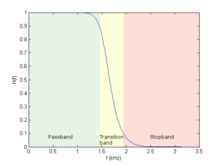24:
91:
The transition band is usually apparent in any filter system, even if it is unwanted. This can be of general importance when calculating the values required for filters used in the control of signal transmission systems, to ensure that the entire bandwidth of the desired signal is allowed to pass.
87:
The transition band can be implemented to allow for a smooth fall off to avoid introducing audible peaks in amplitude. If the transition band of the example 200 Hz filter is 20 Hz, then the signal should start attenuating at 180 Hz, and finally blocked at 200 Hz. The curve that
84:, and cut out all unwanted frequencies above a defined point. If the cutoff point for such a filter is defined as 200 Hz, then in a perfect system, all frequencies above 200 Hz will be stopped and all frequencies below 200 Hz will be allowed to pass through.
88:
the transition band follows depends on the engineering of the filter, including component reaction time and the choice of values for the components that comprise the filter according to mathematical formula.
95:
The transition bandwidth of a filter largely depends on the order of the filter. For a higher order filter, the transition bandwidth is narrower than for a lower order filter. This is due to the fact that
166:
135:
63:
32:
28:
17:
67:
73:
This is the area between where a filter "turns the corner" and where it "hits the bottom".
77:
35:
160:
23:
80:, commonly used in audio systems to allow the bass signal to pass through to a
81:
51:
114:
109:
97:
59:
55:
22:
66:. The transition band is defined by a passband and a stopband
8:
100:is higher for a filter of higher order.
38:filter, with a cutoff frequency of 2kHz.
126:
76:An example of this can be taken from a
7:
54:that allows a transition between a
14:
1:
183:
15:
167:Filter frequency response
16:For indie rock band, see
64:signal processing filter
136:"Design of FIR Filters"
39:
70:or corner frequency.
26:
46:, also called the
40:
29:frequency response
141:. Open Publishing
134:Punskaya, Elena.
18:Transition (band)
174:
151:
150:
148:
146:
140:
131:
68:cutoff frequency
50:, is a range of
182:
181:
177:
176:
175:
173:
172:
171:
157:
156:
155:
154:
144:
142:
138:
133:
132:
128:
123:
106:
78:low-pass filter
44:transition band
21:
12:
11:
5:
180:
178:
170:
169:
159:
158:
153:
152:
125:
124:
122:
119:
118:
117:
112:
105:
102:
27:A plot of the
13:
10:
9:
6:
4:
3:
2:
179:
168:
165:
164:
162:
137:
130:
127:
120:
116:
113:
111:
108:
107:
103:
101:
99:
93:
89:
85:
83:
79:
74:
71:
69:
65:
61:
57:
53:
49:
45:
37:
34:
30:
25:
19:
143:. Retrieved
129:
94:
90:
86:
75:
72:
47:
43:
41:
52:frequencies
33:Butterworth
121:References
82:subwoofer
161:Category
115:Stopband
110:Passband
104:See also
98:roll-off
60:stopband
56:passband
36:Lowpass
145:May 2,
58:and a
139:(PDF)
62:of a
48:skirt
31:of a
147:2020
42:The
163::
149:.
20:.
Text is available under the Creative Commons Attribution-ShareAlike License. Additional terms may apply.

